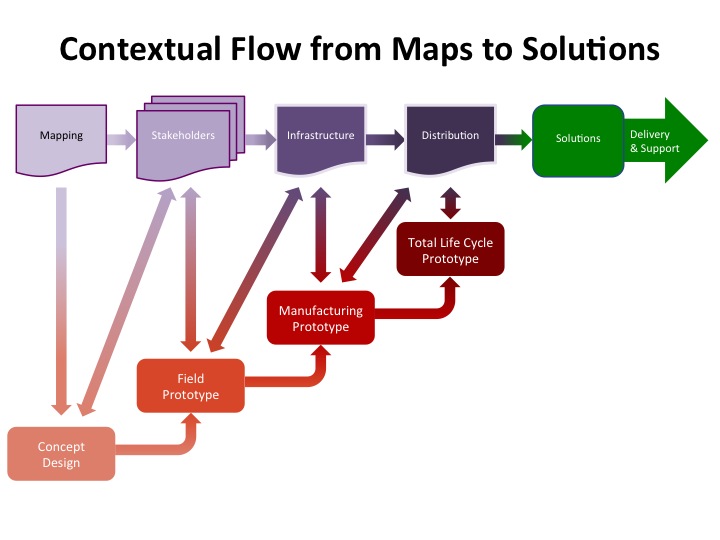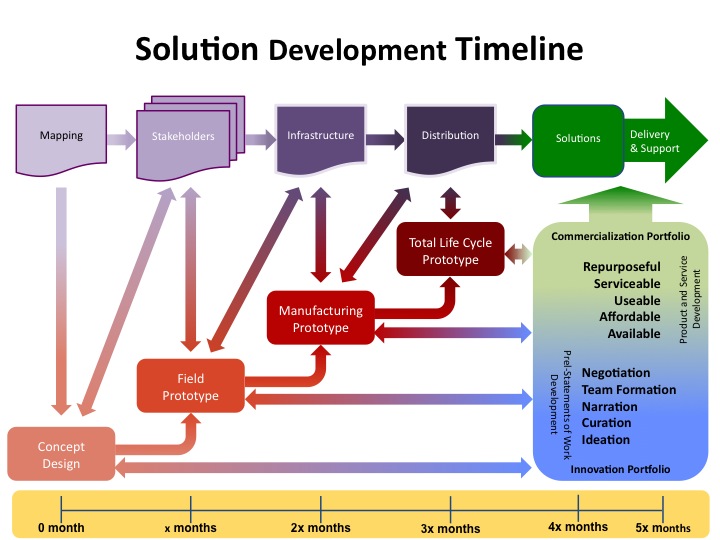User talk:Stevebosserman: Difference between revisions
Jump to navigation
Jump to search
No edit summary |
|||
| Line 2: | Line 2: | ||
Have you ever had such a clever idea you couldn't imagine that it would not be a success then, for whatever the reason, it just didn't develop as you thought it would - maybe not at all? If so, you're not alone. | Have you ever had such a clever idea you couldn't imagine that it would not be a success then, for whatever the reason, it just didn't develop as you thought it would - maybe not at all? If so, you're not alone. | ||
Ideas fail to become viable solutions for many reasons. | Ideas fail to become viable solutions for many reasons. Figure 1 below shows the basic flow of an idea or concept through a series of "tests" or prototype stages to prove its worth as a solution. | ||
Here are the questions it has to answer to go from one stage to the next: | |||
*''Field Prototype:'' Does it work? | *''Field Prototype:'' Does it work? | ||
*''Manufacturing Prototype:'' How does a person make it? | *''Manufacturing Prototype:'' How does a person make it? | ||
| Line 8: | Line 10: | ||
[[File:Basic_Flow_from_Concept_to_Solution.jpg]] | [[File:Basic_Flow_from_Concept_to_Solution.jpg]] | ||
Figure 1 | |||
"Context is everything" as the dictum states. And that is certainly true for concepts / ideas seeking to become solutions. Figure 2 below illustrates the flow of critical aspects about the "solutionizing" context: | |||
*''Mapping:'' What are the characteristics of the landscape where the idea will become a solution? | |||
*''Stakeholders:'' Who will shape the ideas as they move forward? Where are they located? | |||
*''Infrastructure:'' What is the condition, capability, and capacity of the communications, transportation, water, and electric power utilities in the location where the solution will be delivered? | |||
*''Distribution:'' How will the solution get from the point of production to the point of use / consumption? | |||
[[File:Contextual_Flow_from_Maps_to_Solutions.jpg]] | [[File:Contextual_Flow_from_Maps_to_Solutions.jpg]] | ||
Figure 2 | |||
[[File:Flow_from_Innovation_to_Commercialization.jpg]] | [[File:Flow_from_Innovation_to_Commercialization.jpg]] | ||
Figure 3 | |||
[[File:Solution_Development_Timeline.jpg]] | [[File:Solution_Development_Timeline.jpg]] | ||
Figure 4 | |||
Revision as of 20:57, 21 August 2014
Solution Development
Have you ever had such a clever idea you couldn't imagine that it would not be a success then, for whatever the reason, it just didn't develop as you thought it would - maybe not at all? If so, you're not alone.
Ideas fail to become viable solutions for many reasons. Figure 1 below shows the basic flow of an idea or concept through a series of "tests" or prototype stages to prove its worth as a solution.
Here are the questions it has to answer to go from one stage to the next:
- Field Prototype: Does it work?
- Manufacturing Prototype: How does a person make it?
- Total Life Cycle Prototype: How can a person repair it? Or reuse it? Or repurpose it? Or recycle it?
"Context is everything" as the dictum states. And that is certainly true for concepts / ideas seeking to become solutions. Figure 2 below illustrates the flow of critical aspects about the "solutionizing" context:
- Mapping: What are the characteristics of the landscape where the idea will become a solution?
- Stakeholders: Who will shape the ideas as they move forward? Where are they located?
- Infrastructure: What is the condition, capability, and capacity of the communications, transportation, water, and electric power utilities in the location where the solution will be delivered?
- Distribution: How will the solution get from the point of production to the point of use / consumption?



